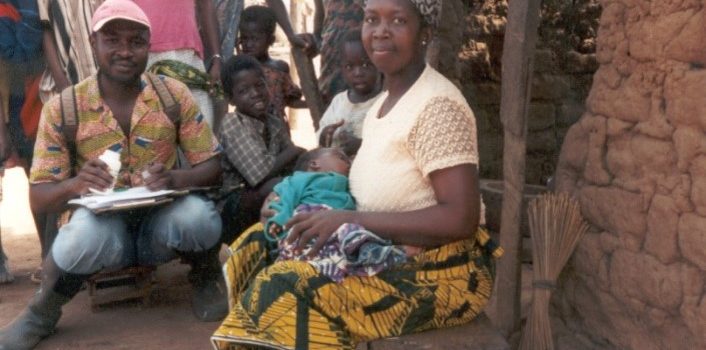Are home visits a cost-effective way to prevent deaths in newborn babies?
London School of Hygiene & Tropical Medicine https://lshtm.ac.uk/themes/custom/lshtm/images/lshtm-logo-black.png Thursday 26 November 2015
Babies born in poor countries can be 50 times more likely to die in their first month of life than babies born in rich countries. In the safest country in the world for newborns, Japan, 1 of every 1000 newborn babies die in their first four weeks of life. In the United Kingdom, 3 of every 1000 newborn babies die. But in Sierra Leone, the most dangerous country for newborns, 50 of every 1000 newborn babies die in their first month – one death for every 20 babies born.
In fact, 85% of all the newborn babies who die each year are born into low- and lower-middle income countries. Each of these tragic deaths imposes a heavy emotional burden on the affected families and on many others.
The good news is that we already know key home care practices and medical interventions that could prevent the majority of these deaths. They include things like starting breastfeeding as soon as possible after birth; making sure that babies are kept warm by wrapping them well and not bathing them too soon; washing hands with soap and water; avoiding putting substances on the umbilical stump which can cause infection; and recognizing danger signs such as inability to suck, fast breathing, fever, or lethargy and taking the baby to a health facility quickly if these danger signs appear. In health facilities, key activities include safe care during childbirth, helping babies breathe immediately after birth, treating sick babies with antibiotics when necessary, encouraging healthy care practices, and caring for preterm babies.
Nearly three-quarters of the world’s 2.7 million newborn deaths could be prevented without high tech care. The problem lies in finding effective and cost-effective strategies to connect newborn babies with these proven healthy care practices and medical interventions.
Six years ago, the World Health Organization (WHO) and UNICEF released a joint statement to recommend home visits as a strategy to reduce newborn deaths. The idea was that a structured package of home visits would provide opportunities to counsel new mothers on care practices, to assess the newborn baby for danger signs and encourage families to seek care at a health facility when necessary. If skilled health workers were not available to do these home visits, WHO and UNICEF recommended that countries train and support lay community health workers – people with a small amount of training, but neither nursing nor medical qualifications – to visit newborns and their mothers at home.
When WHO and UNICEF made this recommendation in 2009, only four studies had been conducted to evaluate home visits for newborns. These studies had demonstrated huge reductions – up to 60% – in newborn death rates, but all of these studies had been conducted in high mortality settings in South Asia, some were quite small-scale, and some had involved curative treatment at home, such as with antibiotic injections. This meant it still wasn’t clear that a home visit strategy could really reduce newborn deaths on a large scale or in other regions of the world.
Our Newhints study evaluated a preventive home visit strategy to reduce deaths in newborn babies in rural Brong Ahafo region in Ghana. The study began with very careful work to understand the local context and to design the specific ways in which the strategy would be implemented. Researchers from the Kintampo Health Research Centre in Brong Ahafo, the London School of Hygiene & Tropical Medicine and University College London worked with district health management teams to develop the strategy, train and supervise an existing cadre of community health workers to carry out a carefully developed package of five home visits, and then to evaluate it.
The Newhints study was conducted on a large scale. More than 400 community health workers in seven districts were trained to conduct home visits. They conducted home visits in half of the 98 zones in these districts, covering a total population of 385,000 people. They didn’t conduct home visits in the other half of the zones so that these zones could be used for comparison within a cluster-randomized study design. The research team estimated that in one year alone, the community health workers conducted nearly 20,000 home visits with nearly 8,000 expectant and new mothers and their newborn babies. About 77% of mother-baby pairs received at least one visit and 21% received the full package of five visits. Ensuring a home visit within a day after the birth proved particularly challenging.
At the end of the trial, the research team estimated that the Newhints home visit strategy had reduced the death rate amongst newborn babies by about 8%. Although the trial was large, it still was not large enough to be sure of this result. There was, however, strong evidence that Newhints had improved home care practices and the rate at which families sought care for sick babies, even though these good practices were already relatively common at the start. A substantial barrier was that even though families sought care, the quality of care for sick newborn in health facilities was not good. When the Newhints results, published in The Lancet, were combined with results from other trials, further analysis indicated that home visits were likely to reduce newborn deaths by about 12%, and that there was a 95% chance that the true reduction was between 5% and 18%.
Compared to the tremendous reductions achieved in the early trials in South Asia, these reductions seemed small. However, the strategy did appear to prevent deaths, just not as many as hoped. It was therefore very important to assess whether this impact was worth the resources home visits would require, or whether Ghana could achieve greater health gains by doing something else with the same resources.
We analyzed the costs and cost-effectiveness of the Newhints home visit strategy, gathering evidence about the value of all of the resources used to deliver the intervention. Our findings, published in The Lancet Global Health today, revealed that the strategy cost just over $10,000 per newborn life saved. Despite the lower-than-hoped-for effectiveness, the Newhints strategy could be highly cost-effective in Ghana. In fact, in Ghana alone, a 12% reduction in the newborn death rate would represent saving thousands of newborn babies who die every year. As we examined what our findings might mean for other places, our analysis showed that the higher the newborn death rate at the start, the lower the cost for each newborn life saved.
The Newhints study was funded as part of the Africa Newborn Network, through Save the Children’s Saving Newborn Lives programme, from a grant from the Bill & Melinda Gates Foundation. Additional funding for the trial was provided by the UK Department for International Development and WHO.
Publication:
- Catherine Pitt, Theresa Tawiah, Seyi Soremekun, Augustinus HA ten Asbroek, Alexander Manu, Charlotte Tawiah-Agyemang, Zelee Hill, Seth Owusu-Agyei, Betty R Kirkwood, Kara Hanson. The cost and cost-effectiveness of newborn home visits: Findings from the Newhints cluster-randomized controlled trial in Ghana’s rural Brong Ahafo region. The Lancet Global Health. DOI: 10.1016/S2214-109X(15)00207-7
Image 1: A fieldworker interviews a mother with her young baby. Credit: Karen Edmond
Image 2: Researchers lead a focus group discussion with mothers to design the home visit intervention. Credit: Alessandra Bazzano.
Our postgraduate taught courses provide health practitioners, clinicians, policy-makers, scientists and recent graduates with a world-class qualification in public and global health.
If you are coming to LSHTM to study a distance learning programme (PG Cert, PG Dip, MSc or individual modules) starting in 2024, you may be eligible for a 5% discount on your tuition fees.
These fee reduction schemes are available for a limited time only.

